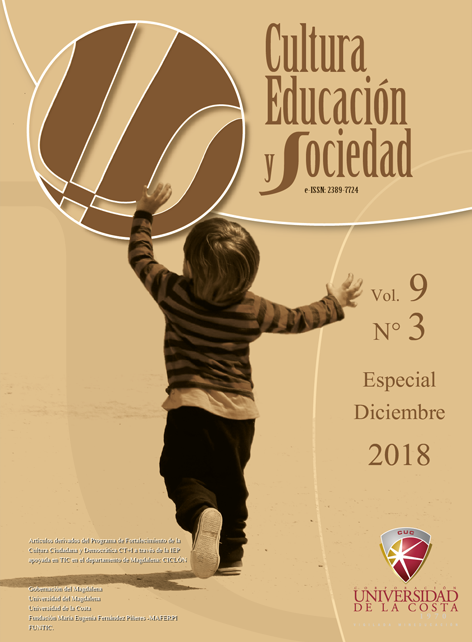Information and communication technologies (TIC) as a strategy to prevent environmental pollution
DOI:
https://doi.org/10.17981/cultedusoc.9.3.2018.83Keywords:
Information and Communication Technology, pedagogical strategy, prevention of environmental pollution, basic education.Abstract
The use of Information and Communication Technologies (ICT) has expanded worldwide and therefore is present in each of the areas in which the human being performs. For this reason, they were considered as the strategy to be used in this project, with the aim of mitigating and preventing environmental contamination with the help of the IED students San Martín de Porres and the community of Fundación, Magdalena. The methodology used was a qualitative and descriptive study, using the action-participatory research model among students, community and teachers. In order to collect the data, individual, institutional and field diary reports were used. During the development of the project, a problem of bad practices was shown in the breeding sites that are located around the institution, which causes environmental contamination and damage to the health of the people.
Downloads
References
Abraham, R., & Vitarelli, M. (2014). La Enseñanza del Ambiente y las TIC en Proyectos Educativos del Nivel Secundario en San Luis. Congreso Iberoamericano de Ciencia Tecnología, Innovación y Educación., (pág. 6). Buenos Aires, Argentina.
Alvarez García, R. E. (2000). Municipio de Fundación: Plan Básico de Ordenamiento Territorial (PBO) 2000-2009. Plan Estructurante Territorial Fundación Siglo XXI, págs. 20-24.
Cabero, J. y Llorente Cejudo, M. (2005). Las TIC y la Educación Ambiental. Revista Latinoamericana de Tecnología Educativa, 4, 13-14.Corredor, A. y Sandino, M. (2009). Las TIC´S como Herramienta de Investigación Científica. Gondola, 2.
Chumaceiro, A.; Hernández de V., J.; Melendez, Y. y Acurero M. (2017). Responsabilidad universitaria y sociedad del conocimiento para la generación de competencias TIC. In book PROCESOS FORMATIVOS PARA EL SIGLO XXI. ISBN 978-980-427-019-2. FONDOUNERMB, Cabimas.
Corredor, A. y Sandino, M. (2009). Las TIC´S como Herramienta de Investigación Científica. Gondola, 2.
Cruz, E. (2016). El ciclo de protesta 2010-2016 en Colombia. Una explicación. Jurídicas CUC, 12 (1), 31-62. DOI: http://dx.doi.org/10.17981/juridcuc.12.1.2016.3
Díaz, C. (2016). Informe de Gestión: Corporación Autónoma Regional del Magdalena. (CORPAMAG). Magdalena.
González, J.; Rodríguez, J.; Cruz, M. y Martínez, C. (2009). Exposisción a Contaminantes Ambientales y Enfermedad Respiratoria: Un Foco de Atención en el Año 2009. Archivos de Bronconeumología., 2.Díaz Granados Martínez, C. F. (2016). Informe de Gestión: Corporación Autónoma Regional del Magdalena (CORPAMAG). Magdalena.
Hernández, R., Fernández Collado, C., & Batipsta Lucio, M. D. (2014). Metodología de la Investigación. México: McGrawHill.
Hidalgo, K.; Cordero, O., Sandí, J. y Cruz, M. (2015). Las TIC como herramienta Pedagógica en Procesos de Investigación Educativa. Investigar en la Educación y Educar en Investigación. Avances y Perspectivas, (págs. 10-11). Costa Rica.
Instituto Colombiano Agropecuario (ICA) (2007). Resolución No. 002640 del 28 de septiembre del 2007. Bogotá.
Meza, A., Arrieta, M. y Noli S. (2018). Análisis de la conciliación extrajudicial civil en la Costa Atlántica colombiana. JURÍDICAS CUC, vol. 14, no. 1, pp. 187-210. DOI: http://dx.doi.org/10.17981/juridcuc.14.1.2018.9
Nieves Cristancho, J., & Salazar Arrieta, F. (2016). e-Supply chain management para una empresa de tecnología. International Journal of Management Sciences and Operations Research, 1(1), 31-34. Recuperado a partir de http://ijmsoridi.com/index.php/ijmsor/article/view/74
Noli, S., Arrieta López, M., & Meza Godoy, A. (2018). Perspectivas sobre la concertación de un convenio bilateral integral entre China y Colombia. Revista Espacios, 39(42), 24. Recuperado de http://www.revistaespacios.com/a18v39n42/18394224.html
Pérez, G. (2002). Desafíos de la Investigación Cualitativa. ResearchGate, 3-4.
Sagastume Gutierrez, A., & Cabello Eras, J. (2017). La educación superior y una producción más limpia. International Journal of Management Sciences and Operations Research, 2(1), 4-8. Recuperado a partir de http://ijmsoridi.com/index.php/ijmsor/article/view/79
Salamanca, E. (2016). Tratamiento de aguas para el consumo humano. Modulo Arquitectura CUC, 29-48
Sepúlveda Perico, A., Martínez Castro, R., Medina Roncancio, S., & Salazar Arrieta, F. (2016). Propuesta de diseño de una red supply chain para la agrocadena de cacao, municipio de Viotá, Cundinamarca. International Journal of Management Sciences and Operations Research, 1(1), 35-42. Recuperado a partir de http://ijmsoridi.com/index.php/ijmsor/article/view/75
Segura, E. (2016). Información, estabilidad y complejidad de aprendizaje en memorias asociativas. International Journal of Management Sciences and Operations Research, 1(1), 49-53. Recuperado a partir de http://ijmsoridi.com/index.php/ijmsor/article/view/77
Valencia, A.; Suárez, R.; Sánchez, A.; Cardozo, E.; Bonilla, M. y Buitrago, C. (2009). Gestión de la Contaminación Ambiental: Cuestión de corresponsabilidad. Revista de Ingeniería, 4.
Downloads
Published
How to Cite
Issue
Section
License
Copyright (c) 2018 CULTURA EDUCACIÓN Y SOCIEDAD

This work is licensed under a Creative Commons Attribution-NonCommercial-NoDerivatives 4.0 International License.
![]()
Creative Commons 2020 CULTURA EDUCACIÓN Y SOCIEDAD
This article is under international license Creative Commons Reconocimiento-NoComercial-SinObrasDerivadas 4.0.
The published articles are the sole responsibility of their authors and do not necessarily reflect the opinions of the editorial committee.
CULTURA EDUCACIÓN Y SOCIEDAD respects the moral rights of its authors, who assign to the editorial committee the patrimonial rights of the published material. In turn, the authors inform that this work is unpublished and has not been previously published.
All articles are under a:
Licencia Creative Commons Atribución-NoComercial-SinDerivadas 4.0 Internacional.
![]()


 English
English
 Español (España)
Español (España)




_12.53_.27_p_. m_._3.png)





_12.57_.35_p_. m_._3.png)
_12.50_.37_p_. m_._3.png)



